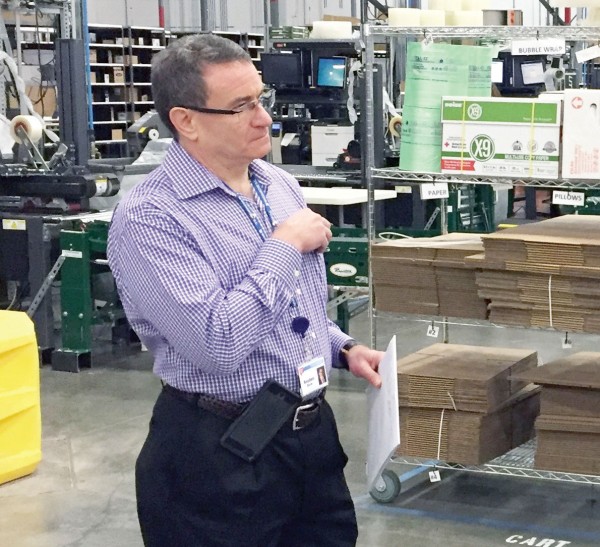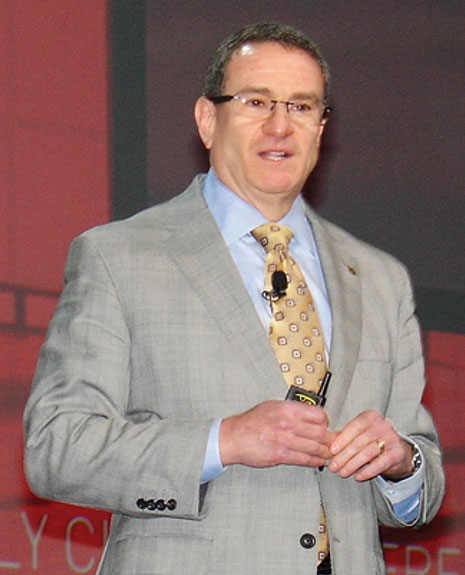Having literally written the book on modern supply chain excellence, Reuben Slone is spearheading initiatives saving Walgreens hundreds of millions of dollars while enhancing safety and providing mutually beneficial opportunities for workers with disabilities.
As senior vice president of supply chain management at Walgreen Co., Slone applies systems thinking and decades of varied experience to making the 8,100-drugstore company more efficient in meeting customer demands, including what he describes as “bringing the clicks together with the bricks” in the firm’s omnichannel approach.
In an interview with AJOT, Slone unassumingly discusses supply chain successes of the $118 billion-a-year-in-sales company and offers some personal insights as well.

Since joining Walgreens six years ago, how have you succeeded in achieving significant inventory and cost reductions and in-stock improvement?
We’re really focused on four outcomes, the first and probably the most critical being safety for all of our team members. We’ve gone from a safety record that was OK to a safety record that we can be proud of for our team members across our supply chain organization.
After that, in terms of taking care of our customers, is the in-stock element or product availability. We had to perfect how we measured that, and, with those more exacting measures, we’ve made better than a 140-basis-point improvement since 2012.
On the inventory front, we’ve taken out about 15 days of inventory while improving in-stock.
And then on the cost front, our supply chain costs as a percent of sales are down 46 basis points over the past five years.
That’s really all been attributed to the right people and the right processes and systems. We have made significant investments, including having recently completed the installation of one of the largest JDA [Software Group] implementations in the world to do our replenishment.
How are you meeting the challenges related to Walgreens’ current acquisition of 1,932 Rite Aid locations?
We also are acquiring three [Rite Aid] distribution centers – one in Dayville, Connecticut; two buildings that make up a distribution center in Philadelphia; and the newest in Spartanburg, South Carolina.
The acquiring of stores and conversion of stores are two different processes. In the acquiring, we take a certain number of stores per week and the employees become members of our organization and all the requirements to operate the store transition to Walgreens.
The conversion, which is when the acquired Rite-Aid stores carry the Walgreens assortment, is really the bigger work for the supply chain organization and the IT [information technology] organization. That’s happening over the next two years and entails lots of planning and design work, with investment to support that.
What new capabilities must today’s supply chain have to appropriately serve modern customers, and how have things changed since your book, The New Supply Chain Agenda, was published by Harvard Business Press in 2010?
As far as the core of the book, nothing has changed. The fundamental laws of the supply chain continue to deal with people, process, technology and change management, where the process component is obviously taking an end-to-end view from your supplier’s supplier through the enterprise to your customer and back, focusing on both internal and external cross-functional collaboration.
In the new environment, it’s less about e-commerce and more about omnichannel, as evidenced by the fact that Walmart bought Jet.com and Amazon bought Whole Foods. So it’s not the death of brick-and-mortar retail but rather a reinvention of retail.
It’s about how you bring the clicks together with the bricks. We’re doing that from a supply chain standpoint. Real-time inventory visibility is critical.
As customers may want to pick up in store or have things delivered to wherever they are, you must possess complete end-to-end cost-to-serve knowledge so you can pick the best way to fulfill a customer order. New systems must support cross-functional processes to enable visibility of inventory as well as costs at each step of the supply chain.
In the distribution centers, we’re also seeing a shift to more each-picking rather than case-picking. 93 percent of what we pick are single items because we’re a small-box retailer. Over time, I think distribution centers will use more goods-to-man by robot or robot-assisted picking.

How have you applied your more than two decades of prior executive experiences at OfficeMax, Whirlpool, General Motors, Federal-Mogul, EDS and Ernst & Young, as well as your engineering education at the University of Michigan, to shaping the Walgreens supply chain?
I think it’s very clear I can’t hold a steady job.
Seriously, I started in the auto industry as an engineer, bringing computer-aided design techniques to bear in the design of vehicles at GM. My mentor was the father of the Pontiac Fiero, Hulki Aldikacti. He taught me vehicle design and, most importantly, systems thinking, which is the most fundamental element of supply chain.
Systems thinking involves understanding how the pieces fit together in the whole. Putting the very best individual pieces together doesn’t necessarily make the best system. You have to learn to optimize through synthesis.
EDS gave me the opportunity to leverage my computer skills. I worked as a consultant at Ernst & Young for about 10 years, so I got to see a lot of different industries. At Whirlpool, I got to see how retailers were dominated by merchants, primarily through Sears, but really the operational collaboration was nonexistent, which created massive problems in the appliance industry. So I could see the need for deep operational collaboration.
As an aside, I’m actually a University of Michigan Ph.D. dropout in biomechanical engineering and kinematics. My research was on design of prosthetics to maximize mobility of people who have lost their leg above the knee.
That leads perfectly to the next question, following up on the presentation you made in February at the Retail Industry Leaders Association’s supply chain conference in Phoenix: How is Walgreens advancing its commitment to employing people with cognitive and/or physical disabilities in the supply chain, and why is this initiative so dear to you?
As a society, we need to look at how we treat people with disabilities as not having a contributing role in our society. Unemployment of those with disabilities run about twice the rate of those without, but the labor force participation rate is the most telling number, where the able workforce is at about 67 percent but the disabled is at about 18 percent. As a society, we’re basically telling people with disabilities, ‘There’s no place for you.’
When I was at OfficeMax, I started working with a Chicago-based NGO [nongovernmental organization], Aspire of Illinois, that provides support for people of all ages with cognitive disabilities.
When I came to Walgreens, my predecessor, Randy Lewis, had already significantly started the journey of hiring people with disabilities in the distribution centers. We’ve continued to build on that.
Maybe the most profound observation is that hiring people with disabilities is not charity. It makes you a better operator. When you look at work design, simplifying the work and making it so you can’t make mistakes is just as good for the so-called able-bodied person as for the disabled person. In many cases, people with autism have savant capabilities, where high-speed repetitive tasks make them feel happiest and most comfortable.
Hiring people with disabilities, while it definitely helps society, also forces you to be a better operator, because you’re doing a better job of designing the work and the training.
What might we find you doing for enjoyment when you are able to escape from work?
I enjoy spending time with my family. My wife, Carolyn, and I celebrated our 30th wedding anniversary in November. Our daughter, Bridget, 23, graduated a year ago from the College of Wooster with degrees in audiology and music composition; she is doing research at Northwestern University. Our son, Henry, is 21 and will graduate in April from the University of Michigan and plans on going to med school to be a psychiatrist.
I work out every day, so that’s my big stress release. I’m very uncoordinated, but I was a runner, doing the half mile and was the anchor in the 2-mile relay, at least through high school.
And my son and I have our own little book club focusing on World War II. We’re typically reading the same books at the same time, but he reads much faster than I do.



